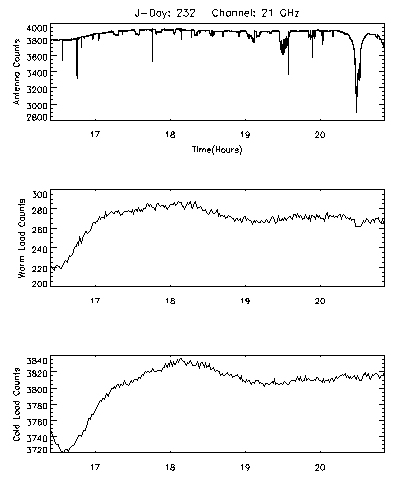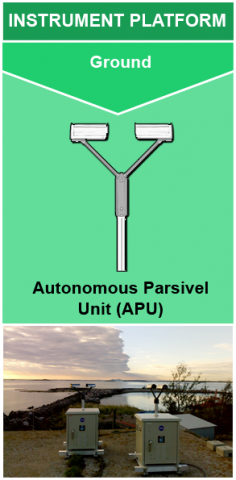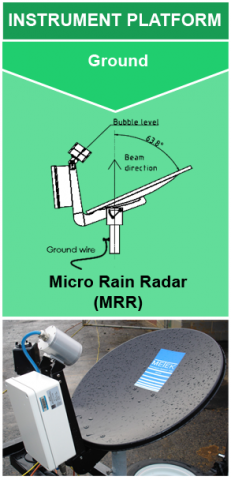 The NASA Global Hydrology Resource Center (GHRC) DAAC published the Dual-frequency Dual-polarized Doppler Radar (D3R) instrument micro article. D3R is a mobile, dual-frequency, fully polarimetric Doppler radar that operates primarily in support of the Global Precipitation Measurement (GPM) mission Ground Validation program. It operates at two frequencies: 13.91 GHz (Ku-band) and 35.56 GHz (Ka-band). These measurement frequencies allow D3R to observe precipitation types ranging from heavy rainfall to snow. The polarimetric and Doppler capabilities of D3R provide further insight into the characteristics and dynamics of precipitation systems. The micro article provides an overview of D3R and its applications to support GHRC’s current and future D3R datasets. The D3R micro article is available here: https://ghrc.nsstc.nasa.gov/home/micro-articles/instrument-dual-frequency-dual-polarized-doppler-radar-d3r
The NASA Global Hydrology Resource Center (GHRC) DAAC published the Dual-frequency Dual-polarized Doppler Radar (D3R) instrument micro article. D3R is a mobile, dual-frequency, fully polarimetric Doppler radar that operates primarily in support of the Global Precipitation Measurement (GPM) mission Ground Validation program. It operates at two frequencies: 13.91 GHz (Ku-band) and 35.56 GHz (Ka-band). These measurement frequencies allow D3R to observe precipitation types ranging from heavy rainfall to snow. The polarimetric and Doppler capabilities of D3R provide further insight into the characteristics and dynamics of precipitation systems. The micro article provides an overview of D3R and its applications to support GHRC’s current and future D3R datasets. The D3R micro article is available here: https://ghrc.nsstc.nasa.gov/home/micro-articles/instrument-dual-frequency-dual-polarized-doppler-radar-d3r
GHRC News
 The NASA Global Hydrology Resource Center (GHRC) DAAC published the Advanced Microwave Precipitation Radiometer (AMPR) instrument micro article. AMPR is a multi-frequency, dual-polarized, cross-track scanning passive microwave radiometer managed by NASA Marshall Space Flight Center (MSFC). AMPR measures microwave brightness temperatures at four calibrated microwave frequencies; 10.7, 19.35, 37.1, and 85.5 GHz. The microwave brightness temperatures observed at these frequencies can be used to derive cloud, precipitation, water vapor, and surface properties including ocean winds. The micro article provides an overview of the AMPR instrument and its applications to support GHRC’s current and future AMPR datasets. The micro article is available here:
The NASA Global Hydrology Resource Center (GHRC) DAAC published the Advanced Microwave Precipitation Radiometer (AMPR) instrument micro article. AMPR is a multi-frequency, dual-polarized, cross-track scanning passive microwave radiometer managed by NASA Marshall Space Flight Center (MSFC). AMPR measures microwave brightness temperatures at four calibrated microwave frequencies; 10.7, 19.35, 37.1, and 85.5 GHz. The microwave brightness temperatures observed at these frequencies can be used to derive cloud, precipitation, water vapor, and surface properties including ocean winds. The micro article provides an overview of the AMPR instrument and its applications to support GHRC’s current and future AMPR datasets. The micro article is available here: The NASA Global Hydrology Resource Center (GHRC) DAAC published the CAMEX-3 DC-8 Airborne Multichannel Microwave Radiometer (AMMR). This dataset is a browse-only dataset that consists of plotted digital count measurements collected by the Airborne Multichannel Microwave Radiometer (AMMR) during the third field campaign in the Convection And Moisture EXperiment (CAMEX) series, CAMEX-3. This field campaign took place from August to September 1998 based out of Patrick Air Force Base in Florida, with the purpose of studying the various aspects of tropical cyclones in the region. The AMMR was mounted onboard the NASA DC-8 aircraft. Daily browse files in GIF format are available for August 20, September 2, and September 17, 1998. It should be noted that the DC-8 aircraft did not operate each day of the campaign, therefore, data are only available on flight days.
The NASA Global Hydrology Resource Center (GHRC) DAAC published the CAMEX-3 DC-8 Airborne Multichannel Microwave Radiometer (AMMR). This dataset is a browse-only dataset that consists of plotted digital count measurements collected by the Airborne Multichannel Microwave Radiometer (AMMR) during the third field campaign in the Convection And Moisture EXperiment (CAMEX) series, CAMEX-3. This field campaign took place from August to September 1998 based out of Patrick Air Force Base in Florida, with the purpose of studying the various aspects of tropical cyclones in the region. The AMMR was mounted onboard the NASA DC-8 aircraft. Daily browse files in GIF format are available for August 20, September 2, and September 17, 1998. It should be noted that the DC-8 aircraft did not operate each day of the campaign, therefore, data are only available on flight days. The NASA Global Hydrology Resource Center (GHRC) DAAC published the Autonomous Parsivel Unit (APU) instrument Micro Article. APU is a laser-based optical disdrometer that measures the size and fall velocity of precipitation particles. APU consists of the Parsivel2 laser disdrometer and its data reporting system. It uses single particle extinction to measure the size and velocity of precipitation particles. The APU transmitter creates a 54 cm2 horizontal measurement area using a 650 nm laser beam. When a particle passes through the measurement area, it reduces the intensity of the laser signal reaching the instrument’s receiver. The magnitude of signal reduction is used to determine the size of the precipitation particle while the duration of the reduction is used to determine the particle’s fall velocity. APU uses these measurements to determine, for example, the drop size distribution and amount of precipitation. APU precipitation data are used for a variety of applications including flood warning systems and atmospheric modeling. The micro article provides an overview of the APU instrument and its applications to support GHRC’s current and future APU datasets. The micro article is available here: https://ghrc.nsstc.nasa.gov/home/micro-articles/instrument-autonomous-parsivel-unit-apu
The NASA Global Hydrology Resource Center (GHRC) DAAC published the Autonomous Parsivel Unit (APU) instrument Micro Article. APU is a laser-based optical disdrometer that measures the size and fall velocity of precipitation particles. APU consists of the Parsivel2 laser disdrometer and its data reporting system. It uses single particle extinction to measure the size and velocity of precipitation particles. The APU transmitter creates a 54 cm2 horizontal measurement area using a 650 nm laser beam. When a particle passes through the measurement area, it reduces the intensity of the laser signal reaching the instrument’s receiver. The magnitude of signal reduction is used to determine the size of the precipitation particle while the duration of the reduction is used to determine the particle’s fall velocity. APU uses these measurements to determine, for example, the drop size distribution and amount of precipitation. APU precipitation data are used for a variety of applications including flood warning systems and atmospheric modeling. The micro article provides an overview of the APU instrument and its applications to support GHRC’s current and future APU datasets. The micro article is available here: https://ghrc.nsstc.nasa.gov/home/micro-articles/instrument-autonomous-parsivel-unit-apu
 The NASA Global Hydrology Resource Center (GHRC) DAAC published the Micro Rain Radar (MRR) Instrument Micro Article. The MRR instrument is a 24 GHz (K-band) continuous wave radar that derives profiles of drop size distributions and rain parameters from measured spectral power backscatter intensity. The Doppler frequency measures the falling velocity of the rain drops. Since drops with different diameters have different falling velocities the backscattered signal consists of a distribution of different Doppler frequencies, which then infers various drop sizes. The spectral analysis of the received signal yields a power spectrum which is spread over a range of frequency lines corresponding to the Doppler frequencies of the signal. These observations can be used for weather radar signal adjustment, hydrological studies, and nowcasting precipitation events among others. The micro article provides an overview of the MRR instrument and its applications to support GHRC’s current and future MRR datasets. The micro article is available at: https://ghrc.nsstc.nasa.gov/home/micro-articles/instrument-micro-rain-radar-mrr
The NASA Global Hydrology Resource Center (GHRC) DAAC published the Micro Rain Radar (MRR) Instrument Micro Article. The MRR instrument is a 24 GHz (K-band) continuous wave radar that derives profiles of drop size distributions and rain parameters from measured spectral power backscatter intensity. The Doppler frequency measures the falling velocity of the rain drops. Since drops with different diameters have different falling velocities the backscattered signal consists of a distribution of different Doppler frequencies, which then infers various drop sizes. The spectral analysis of the received signal yields a power spectrum which is spread over a range of frequency lines corresponding to the Doppler frequencies of the signal. These observations can be used for weather radar signal adjustment, hydrological studies, and nowcasting precipitation events among others. The micro article provides an overview of the MRR instrument and its applications to support GHRC’s current and future MRR datasets. The micro article is available at: https://ghrc.nsstc.nasa.gov/home/micro-articles/instrument-micro-rain-radar-mrr





